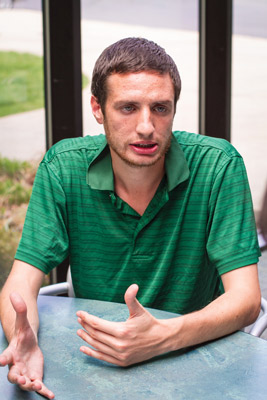
Joseph Luciani, MA ’13, has spent the last year leading a restorative justice pilot program in the Los Angeles Unified School District, the second-largest school system in the United States.
Luciani coaches all the teachers at one Los Angeles school, Augustus Hawkins High School (AHHS), enabling them to run community-building circles with their students at least once per week. He also facilitates circle processes to address disciplinary matters at the school, providing an alternative to traditional methods like suspension. In a low-income neighborhood in South Los Angeles, AHHS students – about 70% Latino and 30% African American – are often dealing with the effects of domestic violence, gangs and poverty in their lives. (Luciani is employed by the California Conference for Equality and Justice, which runs the pilot program at AHHS.)
One goal for the restorative justice program at the school is to interrupt the “school-to-prison” pipeline. Luciani points to data showing that students who are suspended are more likely to drop out of school and become involved with crime. By using restorative justice principles as an alternative method to deal with disciplinary problems, Luciani and his colleagues aim to keep students in school as much as possible, heading off the long-term negative consequences that suspension can set in motion.
According to a preliminary analysis of the program, 124 circle processes involving 1,144 participants were held at the school between September 2013 and March 2014. That total includes 48 community-building circles and 76 conflict and healing circles. Anecdotal evidence from teachers, Luciani says, shows that the community-building circle processes have helped create better learning environments for students.
“Everybody really bought into the process because they saw the transformation that restorative justice was bringing,” said Luciani.
Circles are also becoming a part of the school’s culture, and have even been initiated by students who become aware of conflict.
“The great thing is that it becomes natural,” says Luciani. “If something is happening, it becomes the response: ‘Let’s have a circle.’”
The restorative justice pilot program at AHHS is an early step toward an ambitious goal set by the Los Angeles Unified School District: to implement restorative justice programs across the district by 2020.
Deborah Brandy, school operations coordinator for the district, said that implementation will begin with restorative justice training at all the division’s hundreds of schools. Central office staff will then provide ongoing support to teachers using circle processes and other restorative practices now being put to use by Luciani and his colleagues at AHHS. Several other schools have also begun similar pilot programs.
“The schools that have begun implementing the restorative practices … have seen a difference in the behavior of the students, in terms of feeling more comfortable communicating with peers and with adults,” Brandy said. “If there is a need or an issue, they feel comfortable coming to an adult to discuss it prior to taking action on their own.
“Those skills are critical for helping students become more successful in schools, as well as in society,” she added.
Luciani applauds the district’s commitment to restorative justice, but cautions that it will need significant investment to succeed. Suspending a student is an easy, five-minute process, he says. Facilitating a circle process can take hours, and requires having qualified facilitators already in place. — Andrew Jenner